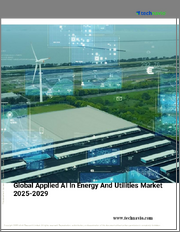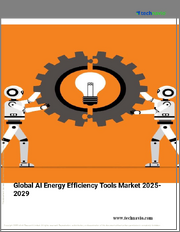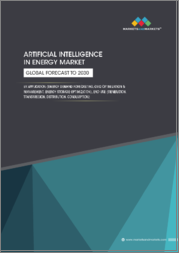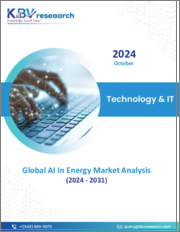
|
시장보고서
상품코드
1817965
세계의 AI 기반 에너지 관리 시장 예측(-2032년) : 컴포넌트별, 전개 모델별, 기술별, 용도별, 최종 사용자별, 지역별 분석AI-Driven Energy Management Market Forecasts to 2032 - Global Analysis By Component (Software, Platforms, Hardware and Services), Deployment Model, Technology, Application, End User and By Geography |
||||||
Stratistics MRC에 따르면 세계의 AI 기반 에너지 관리 시장은 2025년 114억 달러를 차지하고 예측 기간 중 CAGR 30.3%로 성장해 2032년까지 731억 달러에 달할 것으로 예측되고 있습니다.
AI 기반 에너지 관리에는 에너지 생성, 분배, 소비를 최적화하기 위한 인공지능 기술 응용이 포함됩니다. 이 시스템은 센서, 그리드 및 장치의 많은 양의 데이터를 분석하고 수요 예측, 부하 균형 및 효율성을 향상시킵니다. 용도는 스마트 빌딩 및 산업 플랜트에서 재생에너지 통합 및 전기자동차 충전 인프라에 이르기까지 다양합니다. AI 알고리즘은 예지 보전, 고장 검출, 자동 의사결정을 가능하게 합니다. 그 결과 세계적으로 더 탄력적이고 지속 가능하고 비용 효율적인 에너지 생태계를 실현할 수 있습니다.
Google DeepMind의 파일럿에 따르면, 회사의 AI는 데이터센터 냉각에 사용되는 에너지를 40% 줄이고, 이 기술이 효율화에 큰 잠재력을 가지고 있음을 입증했습니다.
에너지 비용 상승과 효율화 요구
세계적인 에너지 가격 상승과 운영 경비 절감에 대한 압박 증가에 힘입어 기업은 AI 기반 에너지 관리 플랫폼에 눈을 돌리고 있습니다. 이러한 솔루션은 실시간 모니터링, 예측 분석, 소비 패턴 최적화를 가능하게 하여 산업, 상업 및 주택 부문 전체의 비용 효율성을 촉진합니다. 지속가능성과 탄소중립 목표에 대한 의식이 높아짐에 따라 채용이 더욱 강화되고 있습니다. 기업이 경제 목표와 환경 목표를 모두 달성하는 것을 목표로 하는 중, 오버헤드를 줄이면서 효율을 극대화하는 지능형 플랫폼에 대한 수요는 크게 가속될 전망입니다.
데이터 프라이버시 및 사이버 보안 취약점
에너지 네트워크의 광범위한 디지털화는 특히 기밀성이 높은 운전 데이터와 소비 데이터와 관련하여 상당한 사이버 보안 위험을 초래합니다. 무단 액세스, 시스템 침해, 랜섬웨어 공격 등의 취약성은 AI를 활용한 플랫폼의 대규모 채용을 방해하고 있습니다. 조직은 규제상의 벌금과 평판 피해를 두려워하며 클라우드 기반 솔루션 전반에 걸쳐 에너지 데이터를 공유하는 데 신중한 자세를 무너뜨리지 않았습니다. 또한 GDPR(EU 개인정보보호규정) 및 기타 데이터 프라이버시 법과 관련된 엄격한 컴플라이언스 요구 사항은 배포를 복잡하게 만듭니다. 이러한 우려는 견고한 보안 프레임워크와 고급 암호화 프로토콜이 업계 전반에 걸쳐 일관되게 도입되지 않는 한 시장 성장을 억제할 수 있습니다.
전기자동차 충전 네트워크의 성장
급속한 EV의 보급과 정부의 지원책에 추진되어, 충전 인프라의 확대는 AI 기반 에너지 관리 제공업체에게 유리한 기회를 가져옵니다. 지능형 소프트웨어 플랫폼은 충전 일정을 최적화하고, 그리드 수요를 예측하고, 재생에너지 통합의 균형을 맞추고, 안정적인 성능을 보장할 수 있습니다. 충전소가 널리 보급됨에 따라 예측 에너지 분석의 필요성이 높아지고 운영자는 비용을 최소화하고 서비스 품질을 향상시킬 수 있습니다. 이 진화는 EV의 성장이 AI 채택을 가속화하고 장기적인 시장 전망을 강화하는 공생 생태계를 창출합니다.
경제 감속으로 인한 투자 여력 저하
경제 불확실성과 세계 경기 침체는 첨단 에너지 기술 투자에 큰 위험을 초래합니다. 경기 후퇴기에는 기업과 공기업이 디지털 변혁에 대한 대처보다 당면의 경영안정을 우선하고 AI의 도입을 늦추는 경우가 많습니다. 자본 지출 감소는 인프라 업그레이드를 늦추고 AI를 활용한 플랫폼 채택을 방해할 수 있습니다. 또한 상품 가격 변동과 스마트 에너지 프로젝트에 대한 정부 자금 감소도 과제를 악화시키고 있습니다. 이러한 상황은 특히 투자 의사 결정이 재정 건전성에 크게 의존하는 비용에 민감한 신흥 국가에서 성장세를 늦출 수 있습니다.
COVID-19의 영향:
COVID-19의 유행은 당초 공급망 지연, 노동력 제약, 투자 연기로 에너지 관리 프로젝트를 혼란시켰습니다. 그러나 이 위기는 탄력적이고 디지털 퍼스트 인프라의 중요성을 부각시켰습니다. 수요 패턴이 변동하는 가운데, 에너지 사용을 최적화하는 방법을 조직이 모색하는 중, 원격 감시와 AI를 활용한 예측이 보급되었습니다. 복구 단계에서 지속가능성에 대한 관심 증가는 채택을 더욱 가속화시켰습니다. 그 결과 팬데믹은 단기적으로는 장벽이 되었지만, 효율화를 위해 전략적으로 필요한 것으로 AI 기반 에너지 관리가 장기적으로 시장에 받아들여지는 계기가 되었습니다.
예측 기간 동안 소프트웨어 플랫폼 분야가 최대가 될 전망
소프트웨어 플랫폼 분야는 엄청난 에너지 데이터 세트의 관리와 분석에 중심적인 역할을 하기 때문에 최대 시장 점유율을 획득할 것으로 예측됩니다. 이러한 플랫폼은 머신러닝, 클라우드 컴퓨팅, IoT 연결을 통합하여 예측 통찰력과 운영 자동화를 실현합니다. 기업은 업종이나 시설에 상관없이 적응할 수 있는 확장 가능한 소프트웨어 툴을 선호합니다. 또한 SaaS 기반 솔루션에 대한 투자가 증가하고 접근성과 비용 효율성이 향상되었습니다. 조직이 원활한 AI 대응 에너지 감시를 목표로 하고 있기 때문에 이 부문은 미래의 채용의 핵심으로 부상하고 있습니다.
예측 기간 동안 AI 기반 에너지 예측 부문의 CAGR이 가장 높아질 전망
예측 기간 동안 AI 기반 에너지 예측 부문이 가장 높은 CAGR을 나타낼 것으로 예측됩니다. 이러한 성장은 불안정한 신재생에너지 통합과 역동적인 소비패턴 중 에너지 수요를 정확하게 예측할 필요성이 높아지고 있다는 배경입니다. 고급 예측 도구를 통해 유틸리티과 기업은 그리드 불안정성을 완화하고 운영 위험을 줄이고 조달 전략을 최적화할 수 있습니다. 신재생에너지의 보급률의 상승과 복잡한 부하변동이 AI 기반 예측의 필요성을 높이고 있습니다. 그 결과, 이 분야는 가장 급성장하는 부문으로 자리매김하고 있습니다.
최대 점유율이 있는 지역:
예측 기간 동안 아시아태평양이 가장 큰 시장 점유율을 차지할 것으로 예상되지만, 이는 급속한 산업화, 에너지 소비 증가, 정부 주도의 스마트 그리드 개념에 기인합니다. 중국, 일본, 인도 등 국가들은 신재생에너지 통합과 AI 기반 에너지 최적화에 많은 투자를 하고 있습니다. 확대되는 도시 인프라와 지지적인 규제 프레임워크는 유틸리티와 상업 부문에서의 채용을 촉진하고 있습니다. 게다가, 제조 집약형 경제권으로부터의 왕성한 수요는 지역의 우위성을 더욱 강화하고 있습니다. 이러한 구조적 수요와 정책적 지원의 융합은 아시아태평양의 리드를 확고히 하고 있습니다.
CAGR이 가장 높은 지역:
예측 기간 동안 북미가 가장 높은 CAGR을 나타낼 것으로 예상되며, 이는 견조한 혁신과 신재생에너지의 보급에 견인된 것입니다. 지속가능성을 중시하는 규제가 강하고, 유틸리티의 디지털화에 적극적으로 임하고 있는 것이 AI를 활용한 솔루션의 도입을 가속화하고 있습니다. 주요 기술 제공업체의 존재는 에너지 신흥 기업에 벤처 자금을 제공함과 동시에 급속한 기술 혁신을 촉진하고 있습니다. 또한 EV의 보급이 진행됨에 따라 AI를 활용한 충전 최적화 수요가 높아지고 있습니다. 기업이 에너지 회복력과 이산화탄소 삭감을 우선하는 가운데 북미가 가장 급성장하는 성장 허브로 부상하고 있습니다.
무료 주문을 받아서 만드는 서비스:
이 보고서를 구독하는 고객은 다음 무료 맞춤설정 옵션 중 하나를 사용할 수 있습니다.
- 기업 프로파일
- 추가 시장 기업의 종합적 프로파일링(3개사까지)
- 주요 기업의 SWOT 분석(3개사까지)
- 지역 세분화
- 고객의 관심에 응한 주요국 시장 추계, 예측 및 CAGR(주: 타당성 확인에 따름)
- 경쟁 벤치마킹
- 제품 포트폴리오, 지리적 존재, 전략적 제휴에 기반한 주요 기업 벤치마킹
목차
제1장 주요 요약
제2장 서문
- 개요
- 이해관계자
- 조사 범위
- 조사 방법
- 데이터 마이닝
- 데이터 분석
- 데이터 검증
- 조사 접근
- 조사 자료
- 1차 조사 자료
- 2차 조사 정보원
- 전제조건
제3장 시장 동향 분석
- 성장 촉진요인
- 억제요인
- 기회
- 위협
- 기술 분석
- 용도 분석
- 최종 사용자 분석
- 신흥 시장
- COVID-19의 영향
제4장 Porter's Five Forces 분석
- 공급기업의 협상력
- 구매자의 협상력
- 대체품의 위협
- 신규 참가업체의 위협
- 경쟁 기업간 경쟁 관계
제5장 세계의 AI 기반 에너지 관리 시장 : 컴포넌트별
- 소프트웨어 플랫폼
- 하드웨어
- 서비스
제6장 세계의 AI 기반 에너지 관리 시장 : 전개 모델별
- On-Premise
- 클라우드 기반
- 하이브리드
제7장 세계의 AI 기반 에너지 관리 시장 : 기술별
- AI의 에너지 예측
- 스마트 그리드 관리
- 에너지 효율 솔루션
- 예지보전 및 장애 검출
- 수요 반응 관리
- 자동 보고서 및 분석
제8장 세계의 AI 기반 에너지 관리 시장 : 용도별
- 재생에너지 관리
- 발전
- 석유 및 가스 부문
- 유틸리티 및 스마트 그리드 시스템
- 상업 및 산업 에너지 관리
- 주택 에너지 관리
제9장 세계의 AI 기반 에너지 관리 시장 : 최종 사용자별
- 유틸리티 및 에너지 공급업체
- 제조업 및 공업 플랜트
- 상업 빌딩
- 주택 소비자
- 정부 및 공공 부문
제10장 세계의 AI 기반 에너지 관리 시장 : 지역별
- 북미
- 미국
- 캐나다
- 멕시코
- 유럽
- 독일
- 영국
- 이탈리아
- 프랑스
- 스페인
- 기타 유럽
- 아시아태평양
- 일본
- 중국
- 인도
- 호주
- 뉴질랜드
- 한국
- 기타 아시아태평양
- 남미
- 아르헨티나
- 브라질
- 칠레
- 기타 남미
- 중동 및 아프리카
- 사우디아라비아
- 아랍에미리트(UAE)
- 카타르
- 남아프리카
- 기타 중동 및 아프리카
제11장 주요 발전
- 계약, 파트너십, 협업, 합작투자
- 인수와 합병
- 신제품 발매
- 사업 확대
- 기타 주요 전략
제12장 기업 프로파일링
- Siemens Energy
- General Electric(GE)
- Schneider Electric
- ABB Ltd
- Honeywell International
- Amazon Web Services(AWS)
- IBM Corporation
- Microsoft Corporation
- Bidgely
- Oracle Corporation
- Vestas Wind Systems A/S
- Atos SE
- C3.ai
- Tesla Energy
- Alpiq AG
- Enel Group
- Origami Energy Ltd
- Innowatts
- Grid4C
- Uplight
According to Stratistics MRC, the Global AI-Driven Energy Management Market is accounted for $11.4 billion in 2025 and is expected to reach $73.1 billion by 2032 growing at a CAGR of 30.3% during the forecast period. AI-driven energy management involves the application of artificial intelligence technologies to optimize energy generation, distribution, and consumption. These systems analyze large volumes of data from sensors, grids, and devices to forecast demand, balance loads, and improve efficiency. Applications range from smart buildings and industrial plants to renewable energy integration and electric vehicle charging infrastructure. AI algorithms enable predictive maintenance, fault detection, and automated decision-making. The result is a more resilient, sustainable, and cost-effective energy ecosystem globally.
According to a pilot by Google DeepMind, its AI slashed the energy used for cooling its data centers by 40%, demonstrating the technology's massive potential for efficiency.
Market Dynamics:
Driver:
Rising energy costs and efficiency demands
Fueled by escalating global energy prices and mounting pressure to reduce operational expenses, enterprises are turning toward AI-driven energy management platforms. These solutions enable real-time monitoring, predictive analytics, and optimization of consumption patterns, driving cost efficiency across industrial, commercial, and residential sectors. Heightened awareness of sustainability and carbon neutrality goals further strengthens adoption. As companies aim to meet both economic and environmental targets, the demand for intelligent platforms that maximize efficiency while reducing overheads is poised to accelerate significantly.
Restraint:
Data privacy and cybersecurity vulnerabilities
The widespread digitalization of energy networks introduces considerable cybersecurity risks, particularly concerning sensitive operational and consumption data. Vulnerabilities such as unauthorized access, system breaches, and ransomware attacks hinder large-scale adoption of AI-driven platforms. Organizations remain cautious about sharing energy data across cloud-based solutions, fearing regulatory fines and reputational damage. Additionally, stringent compliance requirements related to GDPR and other data privacy laws complicate deployment. These concerns could restrain market growth unless robust security frameworks and advanced encryption protocols are consistently implemented across industries.
Opportunity:
Growth of electric vehicle charging networks
Spurred by rapid EV adoption and supportive government initiatives, the expansion of charging infrastructure presents a lucrative opportunity for AI-driven energy management providers. Intelligent software platforms can optimize charging schedules, predict grid demand, and balance renewable energy integration, ensuring reliable performance. As charging stations become more widespread, the need for predictive energy analytics grows, allowing operators to minimize costs and enhance service quality. This evolution creates a symbiotic ecosystem where EV growth accelerates AI adoption, reinforcing long-term market prospects.
Threat:
Economic slowdowns reducing investment capacity
Economic uncertainties and global recessions pose significant risks to investment in advanced energy technologies. During downturns, enterprises and utilities often prioritize immediate operational stability over digital transformation initiatives, delaying AI deployments. Declining capital expenditures can slow infrastructure upgrades, hindering adoption of AI-driven energy platforms. Additionally, fluctuating commodity prices and reduced government funding for smart energy projects exacerbate the challenge. These conditions threaten to stall growth momentum, particularly in cost-sensitive emerging economies where investment decisions heavily depend on fiscal health.
Covid-19 Impact:
The COVID-19 pandemic initially disrupted energy management projects due to supply chain delays, workforce constraints, and deferred investments. However, the crisis highlighted the importance of resilient, digital-first infrastructures. Remote monitoring and AI-powered forecasting gained traction as organizations sought ways to optimize energy use amid fluctuating demand patterns. Heightened interest in sustainability during recovery phases further accelerated adoption. Consequently, while the pandemic posed short-term barriers, it catalyzed long-term market acceptance of AI-driven energy management as a strategic necessity for efficiency.
The software platforms segment is expected to be the largest during the forecast period
The software platforms segment is expected to capture the largest market share, owing to their central role in managing and analyzing vast energy datasets. These platforms integrate machine learning, cloud computing, and IoT connectivity to deliver predictive insights and operational automation. Businesses favor scalable software tools for their adaptability across industries and facilities. Moreover, increasing investments in SaaS-based solutions enhance accessibility and cost-effectiveness. As organizations aim for seamless, AI-enabled energy monitoring, this segment emerges as the backbone of future adoption.
The AI-driven energy forecasting segment is expected to have the highest CAGR during the forecast period
Over the forecast period, the AI-driven energy forecasting segment is anticipated to record the highest CAGR. This growth is propelled by the increasing need to predict energy demand with precision amid volatile renewable integration and dynamic consumption patterns. Advanced forecasting tools allow utilities and businesses to mitigate grid instability, reduce operational risks, and optimize procurement strategies. Rising renewable penetration and complex load variability amplify the necessity for AI-based predictions. Consequently, this segment is positioned as the fastest-growing frontier.
Region with largest share:
During the forecast period, the Asia Pacific region is projected to hold the largest market share, attributed to its rapid industrialization, growing energy consumption, and government-led smart grid initiatives. Countries like China, Japan, and India are investing heavily in renewable integration and AI-enabled energy optimization. Expanding urban infrastructure and supportive regulatory frameworks drive adoption across utilities and commercial sectors. Moreover, strong demand from manufacturing-intensive economies further strengthens regional dominance. This blend of structural demand and policy support cements Asia Pacific's lead.
Region with highest CAGR:
Over the forecast period, North America is expected to witness the highest CAGR, driven by robust technological innovation and widespread renewable energy adoption. Strong regulatory emphasis on sustainability, combined with active utility digitalization efforts, accelerates implementation of AI-driven solutions. The presence of leading tech providers, along with venture funding in energy startups, fosters rapid innovation. Additionally, increasing EV penetration amplifies demand for AI-enabled charging optimization. As enterprises prioritize energy resilience and carbon reduction, North America emerges as the fastest-expanding growth hub.
Key players in the market
Some of the key players in AI-Driven Energy Management Market include Siemens Energy, General Electric (GE), Schneider Electric, ABB Ltd, Honeywell International, Amazon Web Services (AWS), IBM Corporation, Microsoft Corporation, Bidgely, Oracle Corporation, Vestas Wind Systems A/S, Atos SE, C3.ai, Tesla Energy, Alpiq AG, Enel Group, Origami Energy Ltd, Innowatts, Grid4C, and Uplight.
Key Developments:
In Sep 2025, Siemens Energy launched PredictiveGrid Insights, an AI platform that leverages real-time sensor data and weather forecasts to autonomously optimize power flow and prevent cascading failures in transmission networks.
In Aug 2025, Schneider Electric introduced EcoStruxure Microgrid Advisor OS, an AI-driven operating system that enables commercial building clusters to form decentralized energy networks, dynamically trading stored solar power to maximize revenue.
In July 2025, IBM Corporation announced the general availability of IBM Watson for Carbon Performance, a suite of AI models designed to accurately track, predict, and optimize Scope 3 emissions across global industrial supply chains.
Components Covered:
- Software Platforms
- Hardware
- Services
Deployment Models Covered:
- On-Premises
- Cloud-Based
- Hybrid
Technologies Covered:
- AI-driven Energy Forecasting
- Smart Grid Management
- Energy Efficiency Solutions
- Predictive Maintenance & Fault Detection
- Demand Response Management
- Automated Reporting & Analytics
Applications Covered:
- Renewable Energy Management
- Power Generation
- Oil & Gas Sector
- Utilities & Smart Grid Systems
- Commercial & Industrial Energy Management
- Residential Energy Management
End Users Covered:
- Utilities & Energy Providers
- Manufacturing and Industrial Plants
- Commercial Buildings
- Residential Consumers
- Government & Public Sector
Regions Covered:
- North America
- US
- Canada
- Mexico
- Europe
- Germany
- UK
- Italy
- France
- Spain
- Rest of Europe
- Asia Pacific
- Japan
- China
- India
- Australia
- New Zealand
- South Korea
- Rest of Asia Pacific
- South America
- Argentina
- Brazil
- Chile
- Rest of South America
- Middle East & Africa
- Saudi Arabia
- UAE
- Qatar
- South Africa
- Rest of Middle East & Africa
What our report offers:
- Market share assessments for the regional and country-level segments
- Strategic recommendations for the new entrants
- Covers Market data for the years 2024, 2025, 2026, 2028, and 2032
- Market Trends (Drivers, Constraints, Opportunities, Threats, Challenges, Investment Opportunities, and recommendations)
- Strategic recommendations in key business segments based on the market estimations
- Competitive landscaping mapping the key common trends
- Company profiling with detailed strategies, financials, and recent developments
- Supply chain trends mapping the latest technological advancements
Free Customization Offerings:
All the customers of this report will be entitled to receive one of the following free customization options:
- Company Profiling
- Comprehensive profiling of additional market players (up to 3)
- SWOT Analysis of key players (up to 3)
- Regional Segmentation
- Market estimations, Forecasts and CAGR of any prominent country as per the client's interest (Note: Depends on feasibility check)
- Competitive Benchmarking
- Benchmarking of key players based on product portfolio, geographical presence, and strategic alliances
Table of Contents
1 Executive Summary
2 Preface
- 2.1 Abstract
- 2.2 Stake Holders
- 2.3 Research Scope
- 2.4 Research Methodology
- 2.4.1 Data Mining
- 2.4.2 Data Analysis
- 2.4.3 Data Validation
- 2.4.4 Research Approach
- 2.5 Research Sources
- 2.5.1 Primary Research Sources
- 2.5.2 Secondary Research Sources
- 2.5.3 Assumptions
3 Market Trend Analysis
- 3.1 Introduction
- 3.2 Drivers
- 3.3 Restraints
- 3.4 Opportunities
- 3.5 Threats
- 3.6 Technology Analysis
- 3.7 Application Analysis
- 3.8 End User Analysis
- 3.9 Emerging Markets
- 3.10 Impact of Covid-19
4 Porters Five Force Analysis
- 4.1 Bargaining power of suppliers
- 4.2 Bargaining power of buyers
- 4.3 Threat of substitutes
- 4.4 Threat of new entrants
- 4.5 Competitive rivalry
5 Global AI-Driven Energy Management Market, By Component
- 5.1 Introduction
- 5.2 Software Platforms
- 5.3 Hardware
- 5.4 Services
6 Global AI-Driven Energy Management Market, By Deployment Model
- 6.1 Introduction
- 6.2 On-Premises
- 6.3 Cloud-Based
- 6.4 Hybrid
7 Global AI-Driven Energy Management Market, By Technology
- 7.1 Introduction
- 7.2 AI-driven Energy Forecasting
- 7.3 Smart Grid Management
- 7.4 Energy Efficiency Solutions
- 7.5 Predictive Maintenance & Fault Detection
- 7.6 Demand Response Management
- 7.7 Automated Reporting & Analytics
8 Global AI-Driven Energy Management Market, By Application
- 8.1 Introduction
- 8.2 Renewable Energy Management
- 8.3 Power Generation
- 8.4 Oil & Gas Sector
- 8.5 Utilities & Smart Grid Systems
- 8.6 Commercial & Industrial Energy Management
- 8.7 Residential Energy Management
9 Global AI-Driven Energy Management Market, By End User
- 9.1 Introduction
- 9.2 Utilities & Energy Providers
- 9.3 Manufacturing and Industrial Plants
- 9.4 Commercial Buildings
- 9.5 Residential Consumers
- 9.6 Government & Public Sector
10 Global AI-Driven Energy Management Market, By Geography
- 10.1 Introduction
- 10.2 North America
- 10.2.1 US
- 10.2.2 Canada
- 10.2.3 Mexico
- 10.3 Europe
- 10.3.1 Germany
- 10.3.2 UK
- 10.3.3 Italy
- 10.3.4 France
- 10.3.5 Spain
- 10.3.6 Rest of Europe
- 10.4 Asia Pacific
- 10.4.1 Japan
- 10.4.2 China
- 10.4.3 India
- 10.4.4 Australia
- 10.4.5 New Zealand
- 10.4.6 South Korea
- 10.4.7 Rest of Asia Pacific
- 10.5 South America
- 10.5.1 Argentina
- 10.5.2 Brazil
- 10.5.3 Chile
- 10.5.4 Rest of South America
- 10.6 Middle East & Africa
- 10.6.1 Saudi Arabia
- 10.6.2 UAE
- 10.6.3 Qatar
- 10.6.4 South Africa
- 10.6.5 Rest of Middle East & Africa
11 Key Developments
- 11.1 Agreements, Partnerships, Collaborations and Joint Ventures
- 11.2 Acquisitions & Mergers
- 11.3 New Product Launch
- 11.4 Expansions
- 11.5 Other Key Strategies
12 Company Profiling
- 12.1 Siemens Energy
- 12.2 General Electric (GE)
- 12.3 Schneider Electric
- 12.4 ABB Ltd
- 12.5 Honeywell International
- 12.6 Amazon Web Services (AWS)
- 12.7 IBM Corporation
- 12.8 Microsoft Corporation
- 12.9 Bidgely
- 12.10 Oracle Corporation
- 12.11 Vestas Wind Systems A/S
- 12.12 Atos SE
- 12.13 C3.ai
- 12.14 Tesla Energy
- 12.15 Alpiq AG
- 12.16 Enel Group
- 12.17 Origami Energy Ltd
- 12.18 Innowatts
- 12.19 Grid4C
- 12.20 Uplight

















